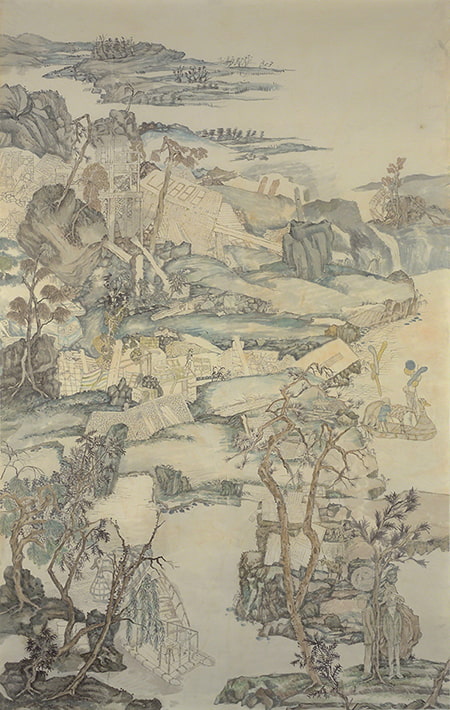Autumn Is Upon Us: Yun-Fei Ji
I’m marking the onset of autumn with a work of art from Chinese American artist Yun-Fei Ji. His work tackles many subjects about contemporary China, as well as world-wide issues such as pollution and climate change. Yun-Fei added a modern twist to the four seasons—a traditional subject in East Asian painting—in his Empty City works. This series of paintings questions the environmental damage that resulted from a massive Chinese dam project.
 |
| Yun-Fei Ji (born 1960, China/United States), The Empty City: Fragrant Creek, 2003. Watercolor on rice paper, 59 5⁄16" x 37 ½" (150.6 x 95.3 cm). Image courtesy of the Brooklyn Museum. © 2024 Yun-Fei Ji. (BMA-5602) |
Yun-Fei’s Empty City works comment on the destruction of ecology in the Yangtze River region after the building of the Three Gorges Dam (1994–2006). The building of this hydroelectric gravity dam and flooding of the Yangtze River for the Three Gorges Reservoir displaced 1.3 million people and caused massive pollution in the river. Each of the eight Empty City works is set during autumn to represent natural cycles coming to an end. The title of this work, The Empty City: Fragrant Creek, refers to the smell pollution created in the Yangtze River as a result of the dam.
Traditional Song dynasty (960–1279) painting was Yun-Fei’s starting point for the painting. The layering of disparately oriented spaces in different scales gives the landscape a surreal feeling. Stylistically, the vertical layering of the landscape that leads the eye through the composition is pure, traditional Song use of space. To bring the viewer back to the 2000s, however, there are numerous political and historical figures interacting in vague narratives that cause the viewer to wonder whether the scene is past or present.
With the founding of the Republic of China in 1912, two thousand years of imperial rule came to an end. Weak efforts of Qing rulers to unite Chinese tradition with Western styles fizzled. In the arts, this meant a schism between traditionalists and innovators. Before the founding of the Peoples' Republic in 1949, many artists showed a willingness to accommodate Western ideas into the inherited painting tradition.
After the Communists took over, their government mandated that Chinese artists pursue “revolutionary realism.” They intended this to celebrate common people and beauties of China. With Western academic realism as a model, Chinese artists ended up painting from life rather than copying ancient masterpieces. However, excessive bureaucratic oversight and political ups and downs caused Chinese art to stagnate. The Cultural Revolution (1966–1976), which was meant to bring society into conformance with the party's progressive ideas, led to the persecution of many well-known artists.
When Chinese Communist Party leader Deng Xiaoping (1904–1997) opened China to the West in 1978, Chinese artists eagerly experimented with Western modernism. Works of the 1970s and 1980s cautiously questioned the values of the Communist Cultural Revolution. This political trend ended after the Tiananmen Square protests and massacre in 1989, although Chinese artists continued to be influenced by Western trends. With the rapid economic boom in China of the 1990s, some artists turned away from political context and experimented within traditional subjects and forms, often in a realist mode.
From the age of two, Yun-Fei was raised on a collective farm outside the city of Hangzhou in Zhejiang province. Without either TV or radio, he was entertained by his grandmother's stories about ghosts and folk tales. He studied traditional Chinese painting in the Song dynasty style, considered the high point of Chinese landscape painting, at Central Academy of Fine Arts in Beijing.
From 1986 to 1989, Yun-Fei attended the University of Arkansas, where he earned his Master of Fine Arts. There he reinvented the traditional structures of Chinese painting, combining history and the present. Now based in New York, his work ranges from critiques of utopian ideals in Chinese painting of the past, the collectivization of Communism, and the obscene consumerism of present Chinese society. Yun-Fei’s earliest works were scroll-like paintings that investigated industrialization and environmental destruction in modernizing China.
Correlations to Davis programs: Explorations in Art 2E Grade 4: Unit 3 STEAM; Explorations in Art 2E Grade 6: 1.1; Experience Art: 1.3; A Personal Journey 2E: 5.1, 5.5; A Community Connection 2E: 1.1, 6.2 Studio Time; A Global Pursuit 2E: 3.3, 4.5; Exploring Visual Design 4E: Another Look at Line; Discovering Drawing 3E: p. 100, p. 128, p. 325; Experience Painting: p. 121, p. 318, p. 337


Comments